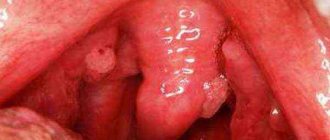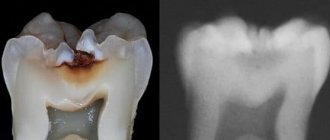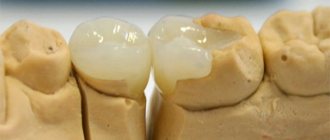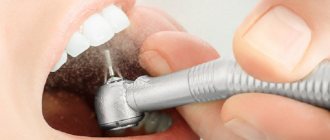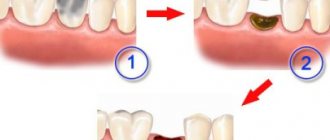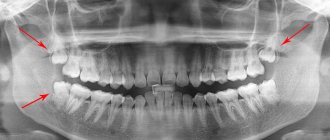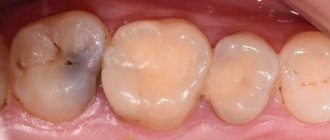Causes of blackening of a tooth under a filling
Dental fillings are the most common therapeutic dental procedure. Filling helps restore a partially lost area of hard tooth tissue in case of various destructions. After installing the filling, the patient expects to get rid of problems. But under the influence of certain factors, the tooth under the filling can turn black and cause a lot of inconvenience to the owner. To eliminate the defect, you must seek help from a specialist.
The tooth under the filling has turned black - secondary caries
Blackening of a tooth due to a filling
Darkening of the enamel and discoloration of the tooth after filling can occur for several reasons. The most common ones are:
- darkening of the filling due to the ingestion of dyes with food, especially for the front incisors;
- staining of a filled tooth with tobacco smoke;
- the tooth darkened under the filling after poor-quality treatment inside;
- installation of metal amalgams having a dark color.
Almost any process of darkening of enamel can be stopped, prevented or cured. Lead a healthy lifestyle, eat more healthy foods, keep your mouth clean and be sure to visit the dentist - and you are guaranteed a dazzling smile.
If the tooth under the filling turns black, you should contact your dentist for diagnosis and determine a treatment method. This symptom indicates the presence of pathological processes that need to be stopped. Let's look at the most common reasons for changes in the appearance of teeth:
- Loss of the protective properties of the seal. The enamel may turn black as a result of the development of so-called secondary caries.
- Blackening may be the result of tartar formation due to ineffective or irregular hygiene procedures. More often this happens in areas that are located in places that are difficult to access for cleaning.
- If prosthetics have been previously performed, then as a result of thinning of the tooth enamel, metal structures - pins and crowns - may become visible.
- The filling turns black as a result of poor quality treatment. If the dentist does not remove all the affected tissue and the infection remains, the darkening will appear within six months.
- Changes in tooth color can be triggered by necrotic processes in the pulp that develop as a result of infectious diseases of the soft tissue of the gums.
The tooth may turn black due to staining with materials that were previously used to install the filling. Perhaps this is the most harmless reason of all listed.
The worst thing is if the darkened dental units begin to hurt. This is a symptom that leaves no doubt that inflammation has begun and urgent medical attention is required. If the dentist removed the nerve during the filling process, then pain even if the filling is lost will not bother the patient.
The presence of obvious discomfort indicates that the root canals were not treated and the nerve remains. Inaction can lead to serious damage and further tooth extraction, the development of cysts and the spread of infection.
Even if the filling has turned black, but remains intact, you cannot postpone a visit to the dentist, because its presence does not provide any guarantee of the safety and health of the tooth.
Blackening of the tooth under a filling: causes and treatment. Reasons for darkening of the filling
If you delay in contacting a doctor, the situation will be aggravated by the appearance of pain. And sometimes darkening indicates destruction of the hard tissues of the tooth. Often the attending physician, not the patient, is to blame for the appearance of darkening. Since before installing a filling, it is necessary to completely clean the carious cavity from dead tissue. A carious cavity or a tooth destroyed in a non-carious way is cleaned using professional equipment. The channels are washed and thoroughly dried for better adhesion of the material.
Before installing a filling, a specialist must check the canals and dentin for the absence of cariogenic microorganisms; for this purpose, a specialized liquid dye is used in dentistry. This procedure allows you to see even the smallest traces of pathogenic microorganisms and re-clean them.
A caries marker shows whether the tooth cavity is well cleaned
If the specialist skipped this stage, then cariogenic microorganisms under the filling will multiply and lead to the appearance of secondary caries.
Indications
Typically, patients turn to dentistry not only when necessary, but also out of personal desire. For example, if after treatment, for one reason or another, a person does not like the result. Most often this happens if the filling technology has been violated. The patient feels discomfort or is not satisfied with the aesthetics of the smile.
Other indications include:
- formation of chips and cracks in the filling material;
- loosening and partial loss of substance from the tooth cavity;
- changes in the color of tissues and shrinkage of the material, leading to a reduction in the volume and quality of the filling;
- the presence of foci of secondary caries, which are best eliminated in the initial stage;
- loose fit of the sealing substance to the edges of the treated tooth cavity.
If you notice such signs and replace the old filling in time, your own teeth will retain their whiteness for a long time and will function without the slightest disturbance. We also advise you to contact qualified specialists and give preference to high-quality raw materials. In this case, any filling will last as long as possible.
Secondary caries is the main cause of darkening
Secondary caries also develops under a correctly installed filling. The reason for the formation of repeated caries is the shrinkage of the filling material. The size of the filling decreases during polymerization, microcavities are formed between the tooth tissue and the filling material. In such cavities, pathogenic microorganisms actively multiply and the tooth darkens.
Shrinkage of the material during hardening occurs due to the use of low-quality materials. But even the most expensive polymer materials shrink if installed incorrectly. If the dentist is unqualified and made mistakes, then this is the main reason why the tooth darkens.
Secondary caries on the front tooth
The most common specialist mistakes:
- Insufficient drying of the tooth cavity before installing the material.
- Laying and polymerizing the material in a single thick layer, instead of gradually laying in small portions.
- Insufficient removal of dead dentin.
Symptoms of secondary caries
The development of secondary caries in the tooth crown is diagnosed by the following symptoms:
- The presence of sensitivity to temperature changes in the filled tooth. This symptom indicates a loose fit of the material to the tooth and access to the pulp.
- Irritants penetrate the holes and the tooth may hurt.
- Darkening of the hard tissues of the tooth. If a tooth under a filling turns black, then such a change in the shade of the tooth indicates the presence of a cavity with pigmented dentin.
- Such darkening should alert you and cause you to contact a specialist.
- Mobility of the material. If the filling material is easily moved by the tongue, then the dentin underneath is destroyed. There is caries, the filling needs to be replaced.
- Having bad breath. If a patient pays due attention to oral hygiene and monitors the condition of his teeth, but the putrid smell does not disappear, this is a reason to get checked. Bacteria accumulate in the spaces between the defective filling and the tooth, and their waste products provoke the formation of a putrid odor.
The presence of darkening of the enamel and pain in the filled crown is a reason to visit the dentist. This situation requires re-treatment of the tooth and installation of a new filling.
X-ray diagnosis of secondary caries
Treatment of secondary caries
Treatment of secondary caries and elimination of tooth darkening occurs according to the standard scheme:
- Removal of defective filling material.
- Cleaning the carious cavity from altered dentin.
- Treatment of the cavity after mechanical cleaning with an antiseptic solution.
- Installation of new filling material and its polymerization.
Treatment of secondary caries begins with the removal of the old filling
If not all parts of a previously damaged filling are removed, caries will develop again.
If it is impossible to completely remove the previous filling due to severe destruction of the dental crown, then the specialist decides to install an artificial crown.
How often does the filling need to be changed?
It cannot be said that the filling has a specific service life, after which it must be replaced, but you need to regularly visit a dentist who, when the first signs of caries appear under the filling, will be able to carry out the necessary treatment and replace the filling.
Nowadays, almost every person has fillings on their teeth. All of them are of different quality, made of different materials. Indeed, there are a large number of materials from which fillings are made, but the most popular are photocomposites, which have high aesthetic and strength characteristics. And their use allows you to make dental treatment quite durable.
The service life of such a filling depends on a number of factors:
- Size, size of the defect - the larger the carious lesion, the less durable the filling will be.
- Condition of hard dental tissues
- The qualifications of the doctor - an experienced doctor, who also performs dental treatment under a microscope, will, of course, place a more durable filling, because it will ensure a tight fit of the material to the tooth tissues.
- High-quality tooth treatment, removal of all carious tissues - you need to be sure that absolutely all carious tissues have been removed; this is why treatment of caries under a microscope is recommended.
- Compliance with all stages of the protocol, mastery of recovery techniques.
- And, of course, careful treatment of teeth - despite the fact that there seems to be no special care for teeth with fillings, high-quality daily hygiene using floss and irrigator, which allows you to remove plaque even in hard-to-reach places, and professional dental hygiene are extremely important mouth
As a rule, a person consults a doctor when something is already bothering him. Basically, it is believed that it does not hurt and does not need to be treated. Unfortunately, caries can develop asymptomatically on teeth that already have a filling, and lead to various kinds of complications. All this happens due to poor quality of previous treatment.
But the doctor will be able to detect the carious process under the installed filling in time. Alarm signals will be a change in the color of the tooth under the filling, staining along the edge of the filling due to a broken marginal fit, the appearance of a “gap” between the filling and the walls of the tooth. X-ray examination or CT scan will help confirm the presence of caries.
It cannot be said that the filling has a specific service life, after which it must be replaced, but you need to regularly visit a dentist who, when the first signs of caries appear under the filling, will be able to carry out the necessary treatment and replace the filling.
Return to list of articles
Other reasons for darkening of crowns under fillings
Darkening of teeth is a common clinical case in dentistry. Often the problem is associated with the use of low-quality filling materials or their improper installation. But there are reasons for tooth discoloration.
External factors
Smoking damages the human body, provokes the development of many dangerous diseases, and affects the color of tooth enamel. Drinking large amounts of coffee and black tea, and other coloring drinks provokes aggravation of the situation.
Sometimes the reason why a tooth under a filling turns black is a disease called fluorosis. Fluorosis occurs with prolonged consumption of foods and water with elevated levels of fluoride. Dark areas form on the enamel and it gradually deteriorates.
Smoking stains fillings
Pathological processes in the oral cavity
Among the factors influencing the darkening of the hard tissues of the crown under the filling are pathological conditions of the oral cavity:
- The presence of a fungal infection. Oral candidiasis is a dangerous fungal disease that provokes discoloration of dental crowns and the development of pathogens.
- Rupture of the nerve bundle due to trauma to the dental crown. When a vascular bundle ruptures, it fills the delicate dentin tissue with blood, which stains the tooth from the inside.
Necrosis of tooth tissue under a filling due to improper treatment
Reasons for darkening of the filling
In dental practice, there are cases when a filling has darkened, but the natural shade of the tooth has not changed. If darkening is detected, you should consult a specialist.
Coloring a filling for a coffee lover
Doctors identify the most common reasons for discoloration of fillings:
- Lack of proper oral hygiene. Despite the inertness of the filling materials to external aggressive influences, pathogenic microorganisms can accumulate in its porous structure. If oral hygiene is not carried out in a timely manner, then there is a high risk of darkening not only of the filling material, but also of the hard tissues of the tooth under the filling.
- Some filling materials change color when you eat colored foods and liquids. Therefore, after installing fillings on visible parts of the dentition, it is better to stop using them excessively. If you cannot limit your intake of drinks, you must use a straw when drinking.
- Whitening procedure after filling. Materials for filling are selected taking into account the natural color of the tooth at the time of installation, and subsequent teeth whitening changes their tone. They look slightly darker after bleaching, and most people choose to replace the material.
Filling correction
Filling correction is understood as a dental procedure that involves restoring or correcting a previously installed filling or restoration.
Filling correction may be required in cases where a previously installed dental filling is partially destroyed or for some other reason loses its original functional or aesthetic properties. This can happen for a variety of reasons. Most often, it is necessary to correct fillings installed several years ago, which, due to improper use or the individual characteristics of the filled tooth, are partially destroyed.
The cause of the destruction of the seal can be various factors. This may be an attempt to chew too hard or hard food, contact of the filling with hard objects (for example, a fruit pit falling on a tooth with a filling). The reason may be the use of outdated or insufficiently high-quality filling materials, which turn out to be much less resistant to physical and chemical influences, or insufficiently high-quality treatment. Filling destruction can also occur during dental procedures on adjacent teeth, especially if extensive and invasive intervention is required, or during dental prosthetics .
Filling correction should be distinguished from filling replacement. The latter has to be resorted to when correction of an existing filling without its complete removal and replacement with a new one is not possible. Compared to replacing a filling, correction is a more preferable procedure, since the invasive effect on the tooth is minimal. When replacing a filling after removing the old filling material and before installing a new filling, some degree of mechanical treatment of the cavity is always required, as a result of which some part of the remaining tooth tissue is inevitably lost. Of course, this is undesirable in any case, so if this is possible, preference should be given to correcting an existing filling.
Correction of a filling can involve various manipulations - restoring the lost part of the filling, changing the position of the filling, correcting its surface, grinding or simple cleaning. The extent and extent of the required manipulations depends on the condition of the filling and the tooth as a whole. Sometimes, due to a number of circumstances, even if it is possible to correct the old filling, the preferred and recommended option will still be to replace it, in order to preserve the integrity of the filled tooth for a longer period of time and better quality. In each case, this issue is resolved by the dentist and the patient individually.
The main condition for being able to restore and correct filling defects with minimal effort and loss is a timely visit to the dentist if these defects occur. Filling correction is possible using any of the modern filling materials . Experienced dentists at our clinic will carry out this procedure quickly and efficiently, which will save you from the need in the future to resort to longer, invasive and expensive treatment to replace the filling with a new one.
come back
Why can a tooth darken under a filling?
Experienced dentists guarantee successful treatment and long-term results. But sometimes the problem appears after a month or two. It is especially unpleasant when the crown under the filling material turns black. What to do in this case? If the tooth under the filling has darkened, you should visit the dentist. Only a specialist can find out the cause of the problem and fix it.
Modern dental treatment involves the use of the latest equipment and advanced technologies. In such situations, the development of pathologies is rare. Provoking factors for the appearance of dark spots:
- Incorrect selection of filling materials;
- Development of carious lesions;
- Effect of injuries, chips, cracks;
- Pulp necrosis;
- Violation of dental canal processing technology;
Practice shows that even with perfect filling, the risk of changing the color of the crown remains. It is especially unpleasant when the problem affects the front incisor. This becomes not only a medical anomaly, but also an aesthetic one. If the filling on the front tooth darkens, the patient loses his attractive smile. When tissues are deprived of nutrition, their shade differs from the color of living ones. In addition, one should take into account the anatomical features of the oral cavity and the abuse of foods that have a coloring effect.
Defects appear from tobacco smoke as a result of sedimentation of resins, from high levels of fluoride in the water that the patient constantly drinks. The situation is negatively affected by insufficient hygiene, as a result of which caries develops. Irregular cleaning of the chewing organs leads to the accumulation of soft and hard brown deposits. Such defects cannot be dealt with without the participation of a dentist. Contact your doctor in a timely manner to avoid complications.
Stages of tooth filling
What is included in the process of filling a tooth? Let's look at this in more detail:
- Local anesthesia. The patient is given an injection that relieves all possible pain. You will not feel pain, because the manipulations are carried out under anesthetic!
- Cleaning and drilling of affected tooth tissues. In case of deep caries or pulpitis, the dental nerve (pulp) can be removed. Before installing a filling, it is very important not to leave the affected tooth tissue, because otherwise, caries will continue to develop, but under the filling material.
- Placement of a dental dam (if necessary) if the tooth structure is not too damaged.
- Selection of material and tooth filling.
- Grinding and polishing of the installed filling. Grinding is necessary to ensure that the process of chewing food remains as comfortable for the patient as before. Polishing of the filling is carried out so that the material does not differ from natural tooth enamel.
Features in the use of materials
It happens that the tooth turns black under the filling due to the fact that low-quality material was used. This can give the crown a brown and black tint. This kind of defect is not easy to fix. Especially when the patient visited another clinic and the therapy was carried out a long time ago. The service life of good composite overlays is at least seven years. But it happens that during treatment the root canal was not completely filled. This causes the problem to appear quickly.
Outdated filling cements can distort light refraction and also become dark from light. In such a situation, pathogenic bacteria actively multiply in the microscopic cavities of the units. This is facilitated by small particles of food that accumulate in the voids. Decay products collect in the dentinal tubules. All this causes a change in the color of the crowns. Even with light enamel, the color of the crowns can change, since the yellowness of the dentin is visible through the transparent layer of enamel.
Today, laser dental treatment is widely used, after which there are no defects. What problems does this technology solve?
- Sterilization of cavities from caries.
- Disinfection of root canals.
- Excision of the pathological “hood”.
- Sterilization of pockets for periodontitis.
- Removing infections and opening abscesses.
- Gum plastic surgery.
Replacing an old filling with a modern light-curing one
Replacing a filling
Replacing a filling is a fairly common therapeutic procedure. The need to replace a filling may arise for various reasons:
- the filling has an unaesthetic appearance;
- destruction of the old filling;
- the seal does not provide the necessary tightness;
- The filling interferes with a normal bite.
Sometimes, as a result of a leak under the filling, inflammation may occur, accompanied by pain in the tooth. In this case, the old filling must be removed immediately to prevent the development of inflammation. Appropriate treatment of the tooth is carried out, after which a new filling is installed from modern materials, completely identical to the color of the tooth.
Why is it worth replacing an old filling?
Replacing an old filling, in the absence of inflammation and pain, is done from an aesthetic point of view. Old amalgam or polymer fillings look unsightly and stand out noticeably against the background of other teeth. The installation of a modern light-curing filling completely hides all traces of dental treatment. The color and shape of the filling fully matches the color and shape of the tooth itself.
Less common are cases where an old filling interferes with a normal bite. Less often - primarily due to the fact that over the years that have passed since the filling was installed, the patient has already become accustomed to it. If you are uncomfortable chewing on one side, or on any treated tooth, this may be a reason to replace the old filling.
Sometimes the filled tooth begins to react to the temperature, or the patient begins to experience pain. It is quite possible that due to a leak in the old filling, an inflammatory process has begun or is about to begin in the tooth. In such a situation, you cannot hesitate. Contact your dentist as soon as possible to have your tooth examined. If the filling is truly leaking, it must be replaced as soon as possible, because delay may lead to the need for more complex treatment.
Advantages of modern fillings
Modern composite fillings have a beautiful appearance and are indistinguishable from the tooth itself. An experienced dentist can shape a composite filling that perfectly matches the natural shape of the tooth and you will not experience any discomfort when chewing.
Errors during the preparation stages and secondary caries
When a tooth under a filling turns black and hurts, this may be the result of poor-quality endodontic treatment. Go to another clinic and be examined using a microscope. This will make it possible to recognize even microscopic errors in previous therapy. From this, secondary caries often develops. It is provoked by shrinkage of cement that is not placed tightly. At the same time, the size of the lining decreases, which creates cavities between the material and the tissues of the masticatory organ. Bacteria thrive in such holes.
Removing an old filling requires the dentist to thoroughly clean the cavity. However, it happens that blood, organic remains, and pus remain inside the unit. When destroyed, they cause a defect in the chewing organ in the form of brown spots. Leaky application of cement or incomplete removal of pathogenic pulp also leads to problems. Common mistakes made by doctors:
- The dentist may not completely dry the tooth cavity before placing composite cement.
- Laying the material in a thick layer at a time, instead of applying it in small portions.
- Careless polymerization.
- Incomplete cleaning of pathological dentin.
After such mistakes, caries forms again. Patients complain of increased sensitivity of crowns, changes in their shade, mobility of the embedded glue, and bad breath. In this case, therapy is needed. First, the defective material is removed, then the cavity is cleaned, then treated with an antiseptic. Finally, a new composite is installed and polymerized.
+7 St. Petersburg, Maly Prospekt V.O., building 4
You can ask any questions you may have and find out the available time for making an appointment with the administrators of the ARTES clinic! Call and come for an appointment!
Other indications for replacing an old filling
Subsidence . Over time, the filling material shrinks (vertical and horizontal).
With vertical subsidence, the height of the bite changes, which can cause dysfunction of the temporomandibular joint. In addition, the shrinkage of the filling changes the height of the contact point between the antagonist teeth (teeth of the upper and lower jaw). And since the teeth experience a lot of stress during the process of chewing food, constant pressure can cause the defective filling to collapse, and along with it, part of the tooth.
When the filling shrinks horizontally, the contact point (point of contact) between adjacent teeth disappears. While eating, food gets stuck between the teeth and constantly injures the interdental (dental) papilla. The gums become inflamed, gingivitis, periodontitis and secondary caries develop.
Overhanging edges of the filling. This defect occurs if the filling material flows onto the gum (rests on it). The overhanging edge of the filling leads to permanent injury to the gums and causes inflammation. Often this phenomenon turns out to be the cause of local periodontitis (periodontitis in the area of one tooth) and secondary caries, since it is impossible to remove food debris from the resulting pocket.
The contact point is formed correctly if the dental floss (floss) forcefully penetrates the gap between the teeth, moves freely along the side surface of the tooth (does not cling to irregularities) and is pulled out with force.
Another reason for replacing an old filling is the incorrect anatomy of the chewing surface of the tooth. Most often this is a consequence of poor quality treatment. The surface of an old filling may be almost smooth and lack pronounced bumps and fissures.
The correct shape of the tooth surface provides not only an aesthetic appearance, but also the performance of chewing functions. The lack of a natural pattern on the chewing surface of the teeth does not allow for effective grinding of food and leads to gastrointestinal diseases.
When biting and grinding food, the teeth experience a heavy chewing load. In order for the antagonist teeth to connect into the correct bite and not experience strong friction against each other, they must touch at points of a small area.
The correct connection to the bite is determined, among other things, by the shape of the surface of the teeth. To create such a surface, a dentist must have a good knowledge of the anatomy of teeth and possess the skill of a sculptor.
You can also replace an old filling aesthetic reasons . Over time, teeth and fillings will change color - this discrepancy may also be a reason for replacement.
What to do if a tooth turns black under a filling?
A filled tooth may not bother a person for a long time, not change its appearance and not show any signs of destruction. However, fillings do not always last for many years and protect teeth from pathological changes. The first sign of destructive processes is darkening of the enamel. What to do if a tooth under a filling turns black? What are the reasons for this phenomenon, and what steps should be taken to avoid losing the tooth altogether?
The tooth under the filling has turned black: causes and solutions to the problem
A filled tooth may not bother a person for a long time, not change its appearance and not show any signs of destruction.
However, fillings do not always last for many years and protect teeth from pathological changes. The first sign of destructive processes is darkening of the enamel.
What to do if a tooth under a filling turns black? What are the reasons for this phenomenon, and what steps should be taken to avoid losing the tooth altogether?
Why does a tooth turn black under a filling?
If the tooth under the filling turns black, you should contact your dentist for diagnosis and determine a treatment method. This symptom indicates the presence of pathological processes that need to be stopped. Let's look at the most common reasons for changes in the appearance of teeth:
- Loss of the protective properties of the seal. The enamel may turn black as a result of the development of so-called secondary caries.
- Blackening may be the result of tartar formation due to ineffective or irregular hygiene procedures. More often this happens in areas that are located in places that are difficult to access for cleaning.
- If prosthetics have been previously performed, then as a result of thinning of the tooth enamel, metal structures - pins and crowns - may become visible.
- The filling turns black as a result of poor quality treatment. If the dentist does not remove all the affected tissue and the infection remains, the darkening will appear within six months.
- Changes in tooth color can be triggered by necrotic processes in the pulp that develop as a result of infectious diseases of the soft tissue of the gums.
The tooth may turn black due to staining with materials that were previously used to install the filling. Perhaps this is the most harmless reason of all listed.
Among the listed reasons, the most common is the development of secondary caries - in this case, the situation can only be saved by repeated filling.
The worst thing is if the darkened dental units begin to hurt. This is a symptom that leaves no doubt that inflammation has begun and urgent medical attention is required. If the dentist removed the nerve during the filling process, then pain even if the filling is lost will not bother the patient.
The presence of obvious discomfort indicates that the root canals were not treated and the nerve remains. Inaction can lead to serious damage and further tooth extraction, the development of cysts and the spread of infection.
Even if the filling has turned black, but remains intact, you cannot postpone a visit to the dentist, because its presence does not provide any guarantee of the safety and health of the tooth.
Additional symptoms
Typically, the appearance of secondary caries is accompanied not only by darkening, but also by a number of other symptoms that are difficult to miss.
What should you pay attention to if your teeth turn black? Let's consider additional symptoms:
- change in enamel color, appearance of a black dot on the surface, darkening and other visual signs of destruction;
- bad breath, especially in the morning after waking up, is the result of the development of pathogens and tissue destruction;
- mobility of the filling, which may eventually partially crumble or fall out completely;
- pain, especially if the nerves are not removed;
- redness of the gums caused by the presence of an inflammatory process.
Even if the blackening of the filling is not accompanied by the additional symptoms described above, it is recommended to undergo a preventive examination so that a specialist can identify the causes of the problem and determine the tactics for further action.
Therapy
If the filling on the front tooth or on any other tooth has darkened, there are three possible solutions to the problem, the choice of which should be determined by the diagnostic results:
- Removal: performed if the tooth is so damaged that it cannot be cured;
- Removing an old filling, treating caries and installing a new filling material;
- Installation of a dental crown after complete elimination of the pathology.
If complications develop and other diseases occur, additional therapeutic measures may be required to eliminate the source of infection and restore the tooth.
Why does a tooth turn black under a filling?
If the tooth under the filling turns black, you should contact your dentist for diagnosis and determine a treatment method. This symptom indicates the presence of pathological processes that need to be stopped. Let's look at the most common reasons for changes in the appearance of teeth:
- Loss of the protective properties of the seal . The enamel may turn black as a result of the development of so-called secondary caries.
- Blackening may be the result of tartar formation due to ineffective or irregular hygiene procedures. More often this happens in areas that are located in places that are difficult to access for cleaning.
- If prosthetics were previously carried out , then as a result of thinning of the tooth enamel, metal structures - pins and crowns - may become visible.
- The filling turns black as a result of poor quality treatment . If the dentist does not remove all the affected tissue and the infection remains, the darkening will appear within six months.
- A change in tooth color can be triggered by necrotic processes in the pulp that develop as a result of infectious diseases of the soft tissue of the gums.
- The tooth may turn black due to staining with materials that were previously used to install the filling. Perhaps this is the most harmless reason of all listed.
Among the listed reasons, the most common is the development of secondary caries - in this case, the situation can only be saved by repeated filling.
The worst thing is if the darkened dental units begin to hurt. This is a symptom that leaves no doubt that inflammation has begun and urgent medical attention is required. If the dentist removed the nerve during the filling process, then pain even if the filling is lost will not bother the patient.
The presence of obvious discomfort indicates that the root canals were not treated and the nerve remains. Inaction can lead to serious damage and further tooth extraction, the development of cysts and the spread of infection.
Dental health: all about fillings and their replacement
What happens when a filling is installed? Do old fillings need to be replaced? Doctors at the dental clinic gave Buro 24/7 answers to these questions
The chief physician of the dental clinic “32 Healthy Teeth” Alexandra Tareva and Honored Doctor of the Russian Federation Lyubov Mikhailova told us in detail about the installation of fillings and the need to replace them.
“Do I need to change the old filling?” This question is often asked by patients to their dentist. The answer is simple: it needs to be changed. It is difficult to believe in the need to replace an old filling with a new one if there is no pain in the tooth. Externally, the filling may look intact, but there are a number of signs that indicate that an examination by a dentist, an x-ray, and in most cases replacement of the filling is required:
• the filling was placed more than 5 years ago;
• the filling has no shine, it is matte and rough;
• the color of the filling has become darker;
• there is a light or dark brown strip along the edge of the filling;
• the boundary between the tooth and the filling is felt.
Why is this happening? The reason is the “shrinkage stress” of the composite filling material. Even during the installation of the restoration, as well as within 2 hours after, “shrinkage” of the material occurs in the tooth cavity. As it hardens, it loses volume. A microspace inevitably forms between the filling and the tooth cavity. Saliva, food and bacteria inevitably enter the microspace. The tooth tissue becomes infected and there is a risk of secondary caries. This process of tooth destruction is very dangerous: the filling has no visible damage, and “carious monsters” affect the tissue. The pain syndrome may occur too late, and then the nerve from the tooth will have to be removed.
Manufacturers of dental materials are constantly struggling with the consequences of material “shrinkage”. To date, “shrinkage stress” has been reduced to 7%, and for flowable fillings - to 2%. Unfortunately, this does not yet completely insure the filling from replacement. Dentists use a special technique when placing a filling - layer-by-layer packing of material. It allows you to reduce volume loss - such a filling will remain unchanged for a long time.
It is also important to remember: the filling material requires careful polishing. The filling should be smooth and shiny. Toothpaste, brush, food scratch the surface layer of the filling. Microcracks and porosity appear. To avoid this, during professional hygiene, doctors carefully polish all old fillings. This not only returns the filling to its former appearance, but also prevents the occurrence of secondary caries. With regular examination and professional hygiene at the dentist, you can delay the time of replacing the old filling, but this procedure cannot be avoided. However, if the filling is already 10 years old, this does not mean that there is a risk of infection of the tissues underneath it.
It is necessary to undergo an examination by a dentist and undergo an x-ray examination. The dentist uses an intraoral camera to demonstrate the condition of teeth and fillings. With its help, both you and your doctor will be able to examine each tooth on the screen under five times magnification and assess the need to replace the filling.”
health
dentistry
Additional symptoms
Typically, the appearance of secondary caries is accompanied not only by darkening, but also by a number of other symptoms that are difficult to miss. What should you pay attention to if your teeth turn black? Let's consider additional symptoms:
- change in enamel color, appearance of a black dot on the surface, darkening and other visual signs of destruction;
- bad breath, especially in the morning after waking up, is the result of the development of pathogens and tissue destruction;
- mobility of the filling, which may eventually partially crumble or fall out completely;
- pain, especially if the nerves are not removed;
- redness of the gums caused by the presence of an inflammatory process.
Poor quality filling materials as a cause of discoloration
To begin with, it is worth remembering that the color of a tooth is given not only by the enamel itself, but also by the dentin that lies underneath it. Therefore, the reasons for the change in surface color may lie deep inside. These include:
- untreated or recurrent caries, as well as other dental diseases,
- penetration of filling materials into the pulp,
- the presence of pins inside the crown, which can be visible through filling materials (for example, after restoration),
- pulp necrosis or absence,
- hemorrhage as a result of injury, impact, when blood penetrates the porous structure of the bone,
- smoking: tobacco tars settle on the surface layer by layer, which over time leads to severe darkening of the enamel,
- prolonged or uncontrolled use of antibacterial drugs (especially tetracycline),
- metabolic disorders in the body and, as a consequence, acid-base imbalance in the oral cavity,
- some gastrointestinal diseases,
- overdose of chemicals (for example, zinc or fluoride),
- frequent consumption of black tea or coffee with insufficient or improper oral hygiene.
All of the above reasons can cause discoloration of the enamel, some of them are quite rare. This article discusses the most common cases.
Some lesions of hard tissues in the oral cavity are asymptomatic in the first stages, so the patient often does not know that he has a problem. Often, it is the darkening of the unit that indicates the presence of a problem. Let's take a closer look at them.
The most common of these problems is tooth decay. Under the influence of bacteria, the protective layer of the crown is destroyed, and the infection penetrates inside. There, the destruction continues, although the outside of the crown may look quite healthy. But when the affected area turns black, this blackness will begin to show through the enamel, and the tooth will appear to have darkened.
Treatment of caries consists of cleaning the hard tissues of the crown from the affected ones, after which the cavity is filled. Sometimes enamel bleaching is required to restore the crown to its original color.
Pulpitis
An acute disease is very easy to detect - by acute pain. In this case, as a rule, the tooth does not have time to change the shade. But if the inflammation has reached a chronic stage, then the pulp (nerve) gradually dies, which can affect the shade of the crown enamel - it becomes purple or gray. The tooth from which the nerve was extracted can also change color - we will discuss such situations in more detail below.
Periapical (that is, located at the apex of the tooth root) granuloma is a consequence of inflammation of periodontal tissue. Inflammation can occur against the background of pulpitis (when the infection penetrates into the soft tissues surrounding the tooth, from above, through the pulp) or against the background of periodontitis (arising from other infectious diseases or as a result of injury). The granuloma begins to grow and compress the surrounding tissue, which is why the unit stops receiving nutrients, darkens and begins to hurt.
We suggest you read: Tooth pain during pregnancy - what to do? Safe treatments. Dentistry for pregnant women
Modern medicine makes it possible to save a tooth using conservative antibacterial treatment or surgery, during which the granuloma is removed along with the root or part of it.
A radicular cyst is a “sac” of serous fluid that is localized at the apex of the roots. The cause of its appearance is chronic periodontitis or granuloma. The causes of periodontitis, in turn, can be any inflammatory processes in soft tissues, caused, for example, by sore throat or sinusitis, tissue trauma, a general decrease in immunity, as well as painful eruption of “eights”.
Radicular cysts are usually treated with surgical methods: cystotomy (opening the cavity and removing its contents) or cystectomy (removing the entire cyst).
The so-called everyday causes of long-term changes in enamel color include the formation of “smoker’s plaque” or “coffee-lover’s plaque.” The fact is that after each meal, bacteria remain on the surface of the crowns, which multiply in the acidic environment of saliva. Over time, this plaque covers the enamel with a dense layer, into which food dyes (when drinking coffee, strong tea, red wine) or tar (when smoking) are absorbed. And even if you brush your teeth after every cigarette you smoke or cup of coffee you drink, it is still impossible to stop the formation of plaque.
Here is a list of products containing natural or artificial dyes that, when consumed daily, can affect the color of the enamel:
- juices (unclarified grape, tomato, pomegranate, cherry),
- sparkling water,
- caramel, lollipops, other sweets,
- soy sauce, ketchup,
- beet,
- berries (blueberries, blackberries, cherries, bird cherry, honeysuckle).
Treatment in this case is carried out using professional hygiene: plaque is removed, and the teeth are whitened, ground and polished.
It happens that the tooth turns black under the filling due to the fact that low-quality material was used. This can give the crown a brown and black tint. This kind of defect is not easy to fix. Especially when the patient visited another clinic and the therapy was carried out a long time ago. The service life of good composite overlays is at least seven years. But it happens that during treatment the root canal was not completely filled. This causes the problem to appear quickly.
Outdated filling cements can distort light refraction and also become dark from light. In such a situation, pathogenic bacteria actively multiply in the microscopic cavities of the units. This is facilitated by small particles of food that accumulate in the voids. Decay products collect in the dentinal tubules.
Today, laser dental treatment is widely used, after which there are no defects. What problems does this technology solve?
- Sterilization of cavities from caries.
- Disinfection of root canals.
- Excision of the pathological “hood”.
- Sterilization of pockets for periodontitis.
- Removing infections and opening abscesses.
- Gum plastic surgery.
Diagnostics
The task of diagnosis is to determine why the filling material and the dental elements underneath have turned black. Professional techniques will help identify the presence of caries and the extent of damage in order to make a final decision on removal or treatment.
Diagnosis consists of a visual examination, as well as an x-ray examination. If concomitant diseases of the oral cavity are suspected, additional diagnostic methods can be used.
Filling services in our clinic
Our clinic in the center of Moscow offers high-quality dental filling services. Experienced dentists with extensive experience approach each client individually and do everything to ensure that the procedure is comfortable. Doctors will choose the type of filling needed after examining the oral cavity. Only high-quality and modern materials are used, which have a long service life.
We perform root fillings without pain or any discomfort. If necessary, we will restore the primary incisors so that they do not further deteriorate and fall out prematurely.
Dentists guarantee a high-quality result - the filling will not differ in appearance from the tooth. It will last for a maximum period, which is determined by the selected material. There are both budget options and expensive ones. The client will be able to choose a specific filling service based on personal needs.
Therapy
If the filling on the front tooth or on any other tooth has darkened, there are three possible solutions to the problem, the choice of which should be determined by the diagnostic results:
- Removal: performed if the tooth is so damaged that it cannot be cured;
- Removing an old filling, treating caries and installing a new filling material;
- Installation of a dental crown after complete elimination of the pathology.
Diagnosis and development of treatment plan
According to the patient, a filling in a tooth from which a piece has broken off lasts for more than 6 years. Upon examination, the doctor saw that a piece of the filling had broken off, and caries had developed under the filling, since the filling had not been sealed for a long time. Orthopedic dentist S.V. Zukor advised removing the old filling completely, treating caries and restoring the tooth with a ceramic inlay. A ceramic inlay on a tooth will make the tooth strong and restore its chewing function in full.
The second complaint was food getting between the teeth.
Human teeth are prone to movement, as the load and tone of the muscles of the tongue, cheeks, and lips change. At any age, gaps between teeth or, conversely, crowding of teeth can appear. In this situation, the front teeth moved forward a little and a gap formed between the tooth and the crown on the implant, which was installed more than 5 years ago at Dial-Dent. Food gets into the gap, which causes discomfort, puts pressure on the gum, and injures it. The crown on the implant is very thoughtfully made with screw fixation. The photo before treatment shows a seal that covers the screw shaft. By removing the filling and unscrewing the screw, you can remove the crown for replacement or correction without damaging the implant.
Prevention
You can prevent blackening of a tooth under a filling with the help of effective prophylaxis. To avoid the need for re-treatment, you should follow several rules:
Firstly, follow all the hygiene instructions of doctors - brush your teeth in a timely and regular manner, using the right toothpaste, floss, and rinses. Secondly, undergo preventive examinations in a timely manner in order to identify and treat any diseases in the early stages, before complications arise.
Try to avoid temperature changes - do not eat hot and cold food at the same time, do not drink hot drinks in the cold. Avoid traumatic effects - do not gnaw hard food (nuts, seeds) with filled teeth. Treat any infectious diseases in a timely manner, including those that are not directly related to the oral cavity.
Get rid of bad habits that disrupt the body’s activities and weaken its protective functions. Do not skimp on tooth restoration and, if the filling has darkened, replace it in a timely manner.
When is it necessary to change the filling?
Obvious reasons for replacing the filling:
- When the old filling has turned yellow and lost its reliability,
- When the tooth started to hurt,
- When part of the tooth next to the filling begins to decay,
- When caries began to develop under the filling,
- As soon as you start to feel an unpleasant taste in your mouth, there is a risk of tooth decay under the filling,
- When the service life of the old filling has expired and there is a risk of tooth decay,
- After taking the picture, the dentist diagnosed the development of caries or incipient pulpitis.
Why did the tooth under the filling turn black?
Dental filling is a therapeutic procedure, thanks to which the doctor restores the chewing ability of the teeth, as well as its anatomical shape. In order for the filling to have an aesthetic appearance, during its creation the dentist uses a composite material whose properties are similar to natural enamel.
With prolonged use, the filling material changes color, which is due to the consumption of coloring products. The filling darkened after installation; the cause of the symptom development is considered to be secondary caries.
When might it be necessary to replace an old filling?
This dental service can be useful in several cases:
- if there is a suspicion or specific symptoms of secondary caries;
- if the filling is loose and is about to fall out;
- if, some time after filling, the material has changed its original color and looks unaesthetic.
Typically, the service life of a filling material depends on several factors - the prevalence of caries, the size and quality of treatment of the carious cavity, the quality of the raw materials used, as well as maintaining oral hygiene.
Cement, which is often used in dental clinics due to its cheapness, can become loose and fall out in the first 12 months from the moment of installation. Acrylic is designed for 3-4 years. Photopolymers are a higher quality material. Fillings made from them can last about 10 years.
Causes of darkening
Slight darkening of the enamel coating occurs as a result of smoking abuse, as well as consumption of large volumes of coffee drinks, soda and tea. Foods that contain high levels of sugar have a negative impact on the composite material, as they reduce the strength of the filling.
The appearance of dark spots on the enamel is promoted by fluorosis, a chronic pathology that develops in patients who consume water with a high fluoride content. A characteristic feature of fluorosis is the fact that the pathological process does not affect a separate chewing unit, but the entire dentition.
Darkening of the tooth occurs as a result of professional bleaching of the chewing units, which is performed after filling the affected dental element. When choosing the color of a composite material, the dentist focuses on the shade of the natural chewing units, and not on the shade that will be obtained after bleaching.
The reason for the change in color of the filling is poor quality oral care. Despite the fact that the composite material is invulnerable to external negative influences, its porous structure is a favorable place for the accumulation of bacteria. In the absence of hygiene, the filling loses its strength, which causes darkening of the hard tissues underneath it.
A change in enamel color occurs in the presence of diseases of the gastrointestinal tract, which are accompanied by a violation of the acid balance or metabolic processes in the body. The dark color of a filled tooth may indicate the presence of a fixing pin in it.
Reasons for replacing a filling
- Depressurization of the filling occurs at the filling-tooth boundary; saliva containing bacteria begins to enter the micro gaps. The environment for bacteria is very comfortable, the rate of reproduction is high, so quite quickly this situation becomes favorable for the development of secondary caries under such a filling.
- Even modern filling materials, especially on large restorations, shrink over time. Such material defects can be divided into two groups: horizontal shrinkage and vertical shrinkage. Even a slight vertical shrinkage of the filling results in a change in the height of the bite, which has a negative impact on the proper functioning of the temporomandibular joint. This will affect the patient’s well-being, headaches, joint pain. All this leads to TMJ pathology. Also, such a tooth may not withstand the redistribution of the chewing load and crack the filling. Which will entail longer and more expensive treatment, including prosthetics or loss of such a tooth. Horizontal shrinkage of the filling leads to a change in the contact point with neighboring teeth. Food getting stuck between these teeth and poor hygiene entails the risk of inflammation of the mucous membrane and the formation of caries.
- The filling is made without an anatomical chewing surface. The cusps and fissures are replaced by a flat surface. It is not right. Such a tooth will not chew food thoroughly, which can subsequently lead to problems with the gastrointestinal tract. Correct anatomy of the tooth surface when it comes into contact with antagonist teeth in small area contacts.
Tooth aesthetics – fillings can change their color and shine. If such a filling is installed in an aesthetically important area, then its owner may experience discomfort from the unsatisfactory appearance of his smile.
Symptoms
If the tooth has darkened as a result of the secondary development of caries, the patient exhibits the following unpleasant symptoms:
- bad breath - bad substances accumulate in the cavity formed between synthetic material and living tissues, which causes the formation of a putrid odor,
- mobility of the filling indicates damage to the dentinal tissue,
- severe pain, the appearance of which is due to an increase in the vulnerability of dental hard tissues to external factors,
- sensitivity of the filled tooth to changes in temperature, as evidenced by the loose contact of the composite to the surface of the tooth and exposure of the pulp.
The manifestation of aching pain syndrome will be the result of dangerous complications. Ignoring unpleasant symptoms increases the risk of premature loss of the sealed chewing element.
Treatment of darkened pulpless teeth
The pulp is a connective tissue with a large number of nerve endings, blood and lymphatic vessels. With its help, the tooth receives nutrition, has the ability to self-heal and fight infection. However, if it is deprived of its pulp, it will stop receiving nutrition, become weak, darken (because there is no nutrition) and eventually crumble. Dentists call such units dead.
Depulping (pulp removal) is a necessary procedure for cleaning root canals in case of pulpitis. However, it happens that the pulp dies without external influence - due to various bacterial lesions that were not treated in time. Thus, it not only stops nourishing the tooth, but also becomes a source of infection, which can affect not only the crown tissue, but also the gums and even the jawbone.
In addition, the color may change due to incorrectly selected root sealing paste. Very often, after filling, such a tooth becomes gray or slightly yellowish, sometimes purple, depending on the color of the paste.
Since dead teeth cannot receive nutrition through the roots, doctors resort to intracanal whitening (endo-whitening). To do this, the dentist opens the canal, cleans it well, and then fills it with whitening gel and closes it with a temporary filling. If the degree of blackening of the unit is large, then the procedure can be repeated after two weeks (but no more than four times in a row).
Another way to solve the problem is to install veneers (lumineers). These are plates that the doctor glues to the visible side of the crown with special glue. Modern dentistry offers a large selection of veneers made of ceramics, zirconium, and composite materials. However, this method of treatment has its contraindications (gum disease, mobility or destruction of the unit, etc.), which should be taken into account when discussing tactics for treating darkened enamel.
Making a crown is another common method of treating darkened, pulpless teeth. It allows not only to restore the unit’s aesthetic appearance, but also to protect it from further destruction. The tooth is ground, polished, and then, using a plaster cast, the dentist makes a crown, which is then placed on the prepared unit.
Restoration is a labor-intensive and short-lived way to solve the problem. This method is based on the fact that the darkened part of the crown is covered with filling material, restoring the aesthetics of the smile. However, the service life of such fillings is short, and the procedure must be repeated again and again.
This is the most radical method of solving the problem, but sometimes it is the only possible one. Removing a unit cannot be avoided in the following cases:
- the crown split, and the split went deep under the gum. If the roots are strong enough, then doctors remove only the supragingival part, and install a pin in the root canal and prosthetize with a crown made of filling materials,
- the tooth is loose, and the gums are injured or bleeding,
- more than 2/3 of the crown is destroyed,
- inflammation of soft tissue or bone (as a rule, in such a situation the tooth is a source of infection).
We suggest you read: White coating and spots on the tongue - ProfiMed
Diagnostic and treatment methods
Darkening of a filled dental element is considered an indication for a visit to the dental office. To determine the cause of the unnatural shade of enamel, the doctor examines the oral cavity and removes the composite material in order to conduct a dental examination.
The doctor must determine the condition of the hard tissues. If the air-water effect on the pulp tissue is accompanied by pain, this is a sign of the development of pulpitis. In the event that pain occurs during percussion (tapping on the cavity of the affected unit), the cause of darkening of the enamel is periodontitis.
After determining the factor that provoked the change in color of the composite material, the doctor begins to eliminate it: he dissects the diseased unit a second time, treats it with medications and forms a new filling.
If the reason for the darkening of the enamel is the development of deep caries, the dentist fills the dental canals, and then begins the restoration of hard tissues.
Monitor the condition of installed seals
We recommend regular examination of the condition of the oral cavity and existing fillings, among other things. This is the only way to guarantee that caries has not begun to develop under or next to the filling. At this stage, stopping tooth decay is much easier than treating pulpitis or more serious diseases of the tooth roots.
The Innovastom Clinic offers a free oral examination and consultation with a dentist. Come to us to learn everything about the health of your teeth.
Examples of our work on installing fillings:
Methods for whitening enamel
There are three main methods of restoring tooth whiteness: restoration of hard tissues, canal whitening and installation of veneers. In advanced cases, the only way to restore the aesthetic appearance of the chewing element is to install a ceramic crown.
Restoration of affected tissues
An alternative way to lighten enamel by restoring hard tissues is through the use of composite materials. First of all, the doctor removes the darkened areas, and then forms a large filling that will cover the visible part of the crown.
In addition to the advantage of being able to save the tooth, restoration has disadvantages:
- The composite material used during the procedure is short-lived.
- The filling has a high degree of absorption and begins to change color under the influence of coloring foods.
To delay re-restoration, the patient should reduce the consumption of carbonated drinks, tea and coffee.
Canal whitening
This method of enamel lightening does not require surgery, which avoids damage to the pulp. Despite this, the active components that make up the whitening gel negatively affect dentin and increase its vulnerability.
Installation of veneers
A veneer is a thin ceramic overlay that is installed on an enamel coating if there are pronounced defects on it. In order for the veneer to fit tightly to the tooth surface and look aesthetically pleasing, the dentist first removes the top layer of enamel.
Installation of crowns
If the dark color of the tooth is the result of the destruction of hard tissues, the dentist uses a prosthetic method to restore the aesthetic appearance. First of all, the doctor grinds down the dental element and removes the affected areas of the hard substance, and then creates an impression of the diseased chewing unit.
A metal-ceramic crown is similar to a natural tooth. The advantage of this type of prosthesis is that it protects the pulp from the aggressive influence of external factors, and also withstands intense chewing load. Metal-ceramic crowns have a low cost, making them accessible to every patient.
Stages of replacing an old filling with a new one
- In this case, we used conduction anesthesia (Ultracaine).
Next, the specialist installed a rubber dam - a latex scarf - in the cavity to isolate the surgical field from moisture and saliva.
Removing the old filling.
A rubber dam is a latex scarf in which you can make a hole for a tooth. It is needed to isolate the tooth that the doctor is directly working with and prevent moisture from entering the prepared cavity.
Human saliva contains a large number of bacteria and microbes. Therefore, the entry of saliva into the prepared cavity under the filling can lead to the development of secondary caries.
After installing the isolation, the doctor begins to remove the old filling. This happens with the help of special diamond burs. When the filling is removed, the dentist prepares the cavity for a future composite restoration. Using mechanical treatment, the remains of the old composite and tooth tissue susceptible to caries are removed.
- After mechanical treatment of the cavity, the doctor etches the cavity of the future filling with a gel containing acids to destroy microorganisms, rinses and thoroughly dries the cavity. After all preparatory measures, our specialist restores the chewing surface of the tooth with composite materials. In this case, the highly aesthetic material ESTELITE ASTERIA was used. This material is specially created for restoration. It has a wide choice of colors and high light transmittance.
The chewing surface is made taking into account the anatomical features; all the cusps and fissures fully convey the appearance of an intact (healthy, untouched by dentists) tooth.
Preventive measures
In order to eliminate the risk of discoloration of the filling, it is recommended to reduce the consumption of coffee drinks, wine, chocolate, and black tea for three days after its installation.
Do you feel nervous before visiting the dentist?YesNo
Another factor that contributes to the staining of filling material is tobacco and tars, so doctors recommend that the patient stop smoking during the rehabilitation period.
If pain occurs after installation of the filling material, the patient is advised to take an analgesic. If the pain persists for more than 3 days and is aggravated by a symptom such as tooth darkening, the patient needs to attend a consultation.
How to keep a filling in its original form?
Nevertheless, sooner or later the filling loses its appearance and requires replacement. On average, a modern light filling can last up to 10 years, depending on the patient’s oral care, the food consumed, and the specific tooth on which the restoration was performed.
To make your filling last longer, remember a few important rules:
- do not chew seeds, nuts and crackers with teeth that have a filling;
- maintain hygiene - you need to brush your teeth twice a day, and visit the dentist every six months for professional cleaning;
- contact only experienced and qualified dentists!
Dental fillings at the First Clinic of Izmailovo, Dr. Bandurina, are carried out by experienced professionals in the field of dentistry.
Prevention of enamel pigmentation
Particular attention should be paid to the care of depulped units, because their service life directly depends on this. Don't overload them. If the pulp has been removed in the front tooth, then it is strictly forbidden to chew seeds, bite off hard food, or use toothpicks and other hard objects to remove food particles. If the molar is depulped, then it is also not recommended to chew hard food on this side - nuts, crackers, chips.
Otherwise, prevention comes down to proper and constant hygiene, visiting the dentist twice a year and following nutritional recommendations.
Video on the topic


